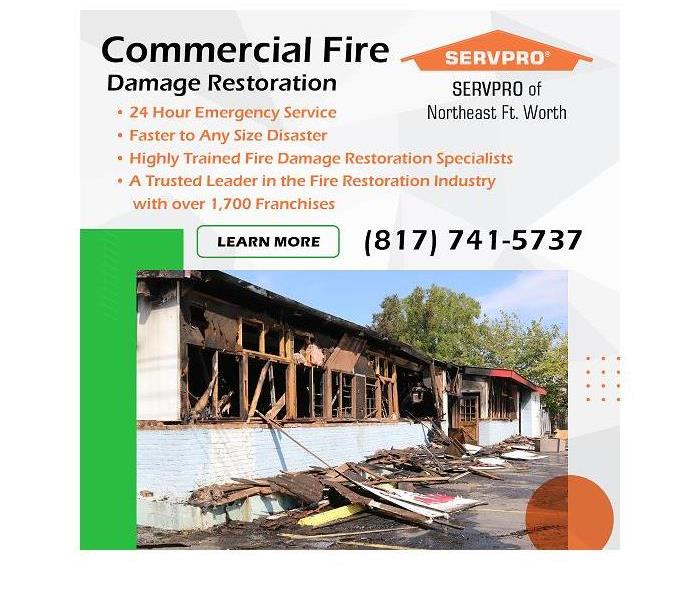Common Causes of Fire Damage in Commercial Buildings
2/10/2021 (Permalink)
Blog Summary: SERVPRO of Northeast Fort Worth explains common causes of commercial fire damage and advises business owners about how they can avoid these fire risks.
Locally owned and operated, SERVPRO of Northeast Fort Worth is the premier commercial property damage restoration company serving the Fort Worth, Keller, and Park Glen areas twenty-four hours a day, seven days a week. SERVPRO of Northeast Fort Worth is a true leader in the restoration industry. Having the highest IICRC standards means customers can trust the property damage restoration team to handle any commercial or residential fire, water, or mold disaster.
Common Causes of Commercial Fires
The U.S. Fire Administration reported that there were an estimated 103,600 non-residential building fires for the years 2009-2018. This works out to about twenty-seven fires per day or a little over one commercial structural fire per hour in the United States.
The most common causes of non-residential building fires included:
- 30.6% - Cooking
- 11.5% - Unintentional, careless
- 9.8% - Intentional
- 7.8% - Electrical malfunction
- 6.9% - Heating
- 5.7% - Open flame
- 5.3% - Other heat
- 4.7% - Other equipment
- 3.8% - Equipment malfunction
- 14.7% - Miscellaneous: appliances, exposure, natural, smoking, causes under investigation
The top six causes listed above account for nearly three out of four non-residential commercial fires.
Restaurants are particularly susceptible to fires. Easter magazine reported that fire departments across America responded to an average of 8,240 structure fires at eating and drinking establishments each year between 2012 and 2016. These fires caused $246 million in property damage.
From 2013-2017, fire departments responded to an estimated average of 4,630 structure fires per year that involved hot work — welding torches, cutting torches, heat-treating, soldering, etc. These fires caused $355 million in direct property damage per year.
By incorporating a comprehensive fire safety and prevention protocol in commercial buildings, many commercial structure fires can be avoided or minimized in their impact. An effective fire safety system has three crucial prongs:
- Detection
- Control
- Extinguishing
Detection: Smoke and fire alarms
Smoke and fire detectors should be strategically located throughout a commercial building. Placement is not enough. Periodic testing and maintenance of each device and the overall system should be a top priority for the facility’s safety coordinator. Smoke and fire detectors not only save lives, but they are also necessary for code compliance.
Control: Fire and smoke curtains
The second prong of an effective fire safety system encompasses controlling the fire and smoke once a fire has erupted. Installing fire and smoke curtains at critical junctures protects employees, machinery, equipment, tools, raw materials, and product. Controlling the spread of the fire and smoke buys time for employees and staff to exit the building. Slowing the spread of fire and smoke also allows more time for the fire department to arrive on the scene, safely assess the situation, and stage the response to the fire.
Extinguishing: Sprinklers and fire extinguishers
The third prong of an effective fire safety system includes extinguishing the fire soon after it breaks out. Over thirty percent of non-residential fires involve cooking. Therefore, restaurants and other food preparation locations, being high-risk zones, should proactively ensure that they are adequately protecting the structure, staff, and customers with sprinklers, well-maintained smoke detectors, fire alarms, and easily accessible fire extinguishers.
Other Crucial Considerations
Having a Fire Prevention Safety Plan is essential for every commercial structure. Many counties in Texas, including Tarrant County, require Third-Party Plan reviews for all new construction projects to include building and fire protection systems. Project owners must still apply for all applicable permits with the Fire Marshal’s Office.
The success of any fire safety plan depends upon effective training. When a fire erupts in a manufacturing unit or a warehouse full of combustibles, employees and staff have only minutes to save data, shut down production lines, secure the facility, and escape. Every second counts. Disciplined training saves lives.
Finally, fire and water damage restoration must be achieved rapidly. When a production line, retail sales outlet, restaurant, or service center goes offline or idle, profits plummet. To help businesses recover quickly from water and fire damage, SERVPRO of Northeast Fort Worth will work with business owners before disaster strikes to formulate a Ready Plan.
SERVPRO of Northeast Ft. Worth specializes in the cleanup and restoration of residential and commercial properties after fire, smoke, or water damage. For more information about fire damage restoration, contact SERVPRO of Northeast Fort Worth, TX, at (817) 741-5737 or email office@SERVPROnortheastftworth.com.





 24/7 Emergency Service
24/7 Emergency Service
